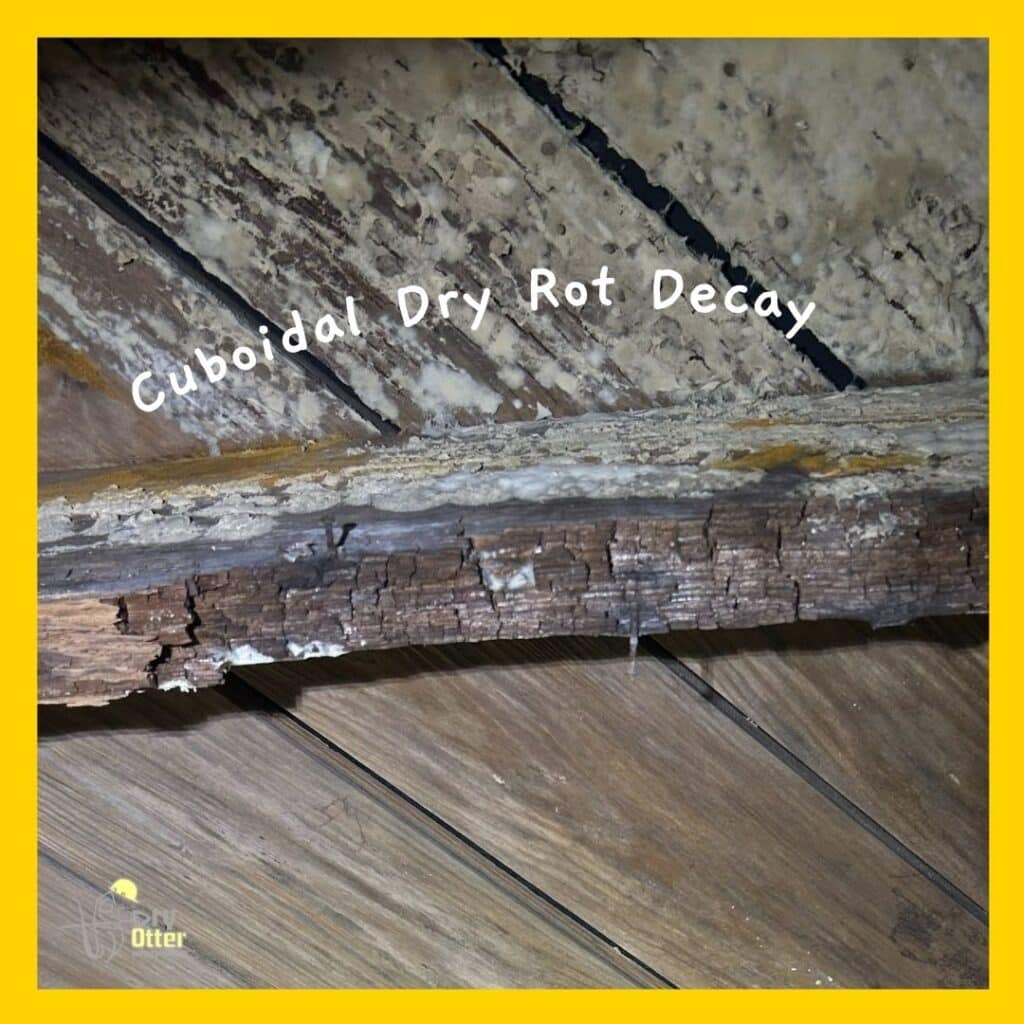Ever noticed crumbly, decayed wood under your home? That’s the handiwork of dry rot, a sneaky fungus that feeds on damp wood. It’s like a termite’s tiny evil twin, munching away at your walls, floors, and roof. In this article I’ll tell you what dry rot is, dry rot early signs, what causes dry rot, and how to prevent dry rot.
What Is Dry Rot?
So what is dry rot? It’s a type of wood decay that can be common in the crawl spaces under homes when they are not properly waterproofed. Let’s uncover the truth about dry rot and how to give it the boot before it eats you out of house and home.
What Causes Dry Rot?
Dry rot is caused by a type of fungus that feeds on wood cellulose and hemicellulose. The main culprits are Serpula lacrymans and Meruliporia incrassata. These fungi love damp wood and can spread quickly through building materials, leaving destruction in their wake. Dry rot starts out as a small patch of crumbly, dry wood. But before you know it, the rot spreads throughout your floor joists, compromising their structural integrity. Dry rot needs three things to thrive: moisture, oxygen, and a food source (wood). Eliminating any one of these will stop dry rot growth.
Stages of Dry Rot
Dry rot goes through several stages as it grows and spreads:
- Hyphal stage – thin fungal strands called hyphae begin to colonize the wood
- Mycelium stage – hyphae mass together to form white, cotton-like mycelial growth
- Sporophore stage – fruiting bodies develop and release spores to spread the fungus
- Decay stage – wood becomes brittle, cracks into cubes, and disintegrates

Catching dry rot early is key. The longer it grows, the more damage it causes. Regular inspections can help you spot dry rot before it gets out of hand.
Dry Rot Early Signs
Think you might have a dry rot problem? Here are some telltale signs to look out for: One of the most obvious dry rot early signs is visible fungal growth on wood surfaces. You might see white, fluffy mycelial mats or the rusty, pancake-like fruiting bodies. These fruiting bodies release millions of spores into the air. Breathing in these spores can cause respiratory issues, so it’s important to address dry rot promptly.
Discolored or Cracked Wood
Dry rot can cause wood to darken and shrink, leading to deep cracks that form cube-like shapes. This “cuboidal cracking” is a classic sign of advanced dry rot. The affected wood may also have a silky grey sheen to it. If you see these symptoms, the dry rot infestation is likely widespread and causing significant timber decay. Dry rot fungi digest the parts of the wood that give it strength. As a result, affected timber will feel soft, spongy, or crumbly. Poke a screwdriver into the wood. If it sinks in easily or the wood crumbles, you probably have dry rot.


What Does Dry Rot Smell Like?
Active dry rot growth often produces a damp, musty, or mushroom-like smell. If you notice an earthy odor coming from the crawl space, it’s time to investigate for dry rot.
How to Prevent Dry Rot
The best way to deal with dry rot is to prevent it from happening in the first place. Here are some tips:
- Keep your home’s humidity levels below 60%
- Fix leaks and moisture issues promptly
- Ensure proper ventilation, especially in damp areas like bathrooms and kitchens
- Use pressure-treated or naturally rot-resistant wood for outdoor projects
- Apply a preventative fungicide to at-risk timber
Use Wood Resistant to Dry Rot
The best way to avoid dry rot wood is to choose wood species that are naturally resistant to decay during the building process. Some good options include:
- Cedar
- Redwood
- White oak
- Teak
- Mahogany
These woods contain natural compounds called extractives that help protect against fungal growth. They’re a great choice to avoid dry rot wood.
Get Regular Inspections
Finally, schedule regular inspections of your home to catch dry rot early. A trained professional can spot the signs of dry rot and recommend treatment options. Aim for an inspection at least once a year, or more often if you live in a damp climate. Catching dry rot early can save you thousands in repair costs down the line. Prevention is always better than cure. By controlling moisture, using resistant materials, and staying vigilant, you can keep your home free from this destructive fungus.
How to Repair Dry Rot
If you’ve discovered dry rot in your home, it’s important to act quickly. The longer you wait, the more damage the fungus can cause. The first step in treating dry rot is to eliminate the moisture source that’s allowing it to grow. Here’s what to do…
- Fix any plumbing leaks
- Remove and replace all affected wood
- Treat remaining timer with a fungicide that contains boron
- Waterproof the crawl space with encapsulation and a dehumidifier
These steps are ideally to be done by a professional.
Conclusion
So there you have it, the lowdown on the crumbly culprit known as dry rot. This fungal menace may seem unstoppable, but with a keen eye and swift action, you can send it packing.
Remember, moisture is dry rot’s best friend. Banish dampness and you’ll starve the beast. Regular home check-ups are key to catching it early. And if you do spot the signs, don’t panic. Call in the pros and they’ll have your home rot-free in no time. Schedule your free crawl space inspection and get a quote to repair your crawl space with dry rot today!











